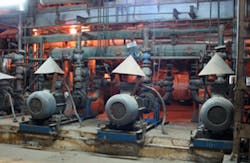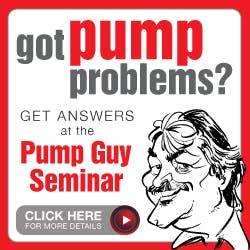Every journey begins with the first step. Efficiency and conservation are the first steps on the path toward energy independence.
Efficiency is “energy output” divided by “energy input.” With pumps, energy output is head (PSI) and flow (GPM) leaving the pump discharge nozzle. Energy input is horsepower or kilowatts.
The pump performance curve lists the total efficiency at different flows. The total efficiency of a pump is composed of three elements—the mechanical efficiency, the volumetric efficiency, and the hydraulic efficiency. The total efficiency is not the average of the three elements; the total efficiency is the worst of the three elements. If two of the elements are 95 percent efficient and the third element is 50 percent efficient, the total efficiency is 50 percent. Let’s consider each.
Mechanical Efficiency
In a pump, mechanical efficiency refers to touching, binding parts in relative motion. A shop mechanic can manually spin the rotating assembly of a properly aligned and assembled centrifugal pump equipped with a mechanical seal and roller bearings. Most centrifugal pumps feature only two or three points of physical rubbing contact:
- A modest spring load keeps the rotating face of the mechanical seal in physical contact with the stationary face.
- The lubricated bearing balls or rollers have points of rolling contact with the inner and outer races of the bearing assembly on the shaft.
- Rubber lip oil seals physically contact the rotating shaft.
Other than these points of physical contact, nothing else touches inside a properly assembled centrifugal pump. The rotating impeller doesn’t contact the internal volute housing. Although in close proximity, the rotating wear bands don’t touch or rub the stationary wear bands. Therefore, the mechanical efficiency in a centrifugal pump with a mechanical seal is quite high, maybe 98 percent or 99 percent, unless parts are binding. If parts are binding, then this is your real problem.
Misaligned, binding parts will really drag down the mechanical efficiency, and thus the total efficiency. This is the best argument for accurate alignment and precise measurements.
The mechanical efficiency is normally less with a packed pump and with positive displacement (PD) pumps. The packing rings gripping the rotating shaft or sleeve really reduce the mechanical efficiency of a centrifugal pump. And PD pumps normally feature gears, lobes, pistons, plungers, sliding-seats, and wear plates in abrasive physical contact.
Volumetric EfficiencyAdmittedly, a minute quantity of liquid slips through the gap at the wear bands and makes two, maybe three passes through the impeller. If the pump is operated away from design, even more liquid is recirculated through the impeller. Balance holes in the impeller face also increase the recirculation. Open impellers exhibit even more slippage and recirculation through open gaps. I’ll talk about this in a moment.
The volumetric efficiency is drastically reduced with a packed pump. Packing must leak to work properly. These losses can be quantified. Simply collect and record the leakage over time at the stuffing box. The pump’s total efficiency is dragged down too with the reduced volumetric efficiency. Dripping through gaskets and spewing mechanical seals also reduce the volumetric efficiency.
Leaks are preventable and unacceptable. The Pump Guy encourages everyone to reduce leaks and improve the volumetric efficiency. Convert packing to seals where possible. Convert single seals to double seals with volatile liquids. Double seals will contain fumes and vapor that might escape through an o-ring or the faces of a single seal.


